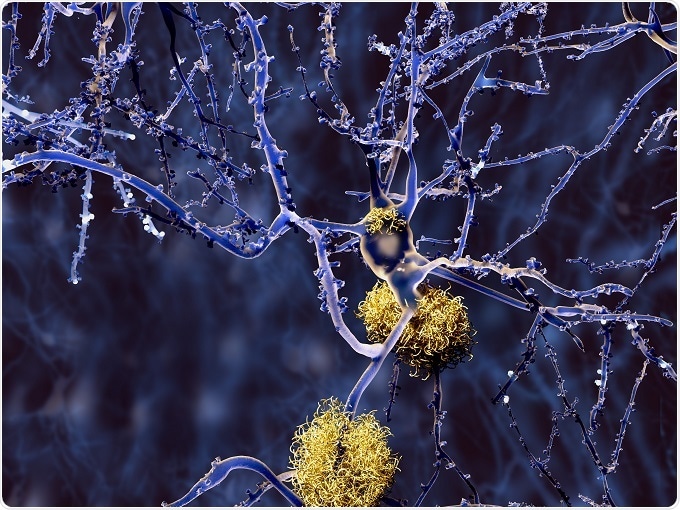Jun 15 2017
A new study led by the Keck School of Medicine of University of Southern California (USC) reveals that older adults with elevated levels of brain-clogging plaques, yet normal cognition, experience faster mental decline, suggestive of Alzheimer's disease. The study published in The Journal of the American Medical Association on June 13 presented the earliest precursor—the toxic and sticky protein as part of the disease, before symptoms arise.
 Alzheimer's brain: Neuron with amyloid plaques. Credit: Juan Gaertner/Shutterstock.com
Alzheimer's brain: Neuron with amyloid plaques. Credit: Juan Gaertner/Shutterstock.com
All researchers see amyloid plaques as a risk factor for Alzheimer's. However, this study looked at 10 years of data from the Alzheimer's Disease Neuroimaging Initiative—an exploration of the biomarkers that signify Alzheimer's.
"To have the greatest impact on the disease, we need to intervene against amyloid, the basic molecular cause, as early as possible," said Paul Aisen, senior author of the study and director of the USC Alzheimer's Therapeutic Research Institute (ATRI) at the Keck School of Medicine. "This study is a significant step toward the idea that elevated amyloid levels are an early stage of Alzheimer's, an appropriate stage for anti-amyloid therapy."
The asymptomatic stage, the incubation period with elevated amyloid plaques, can last longer than the dementia stage.
This study is trying to support the concept that the disease starts before symptoms, which lays the groundwork for conducting early interventions,"
Michael Donohue, lead author of the study and an associate professor of neurology at USC ATRI.
The researchers linked the brain amyloid plaque to cholesterol in the blood. Both are warning signs with few outward symptoms until a disastrous event occurs. Aisen, Donohue, and others anticipate that treating the symptoms—amyloid removal, at the preclinical stage will slow down the onset or even prevent Alzheimer's or a heart attack; the effects of which may not be reversible and too late for treatment.
"We've learned that intervening before the heart attack is a much more powerful approach to treating the problem," Donohue said.
As far as the amyloid problem is concerned, Aisen noted that one in three people over 65 have elevated brain amyloid. The study indicated that most people with elevated amyloid will progress to Alzheimer's symptoms within 10 years.
The current estimate of Alzheimer's among Americans is 5.4 million. The study stated that if Alzheimer's prevalence estimates include the preclinical stage before symptoms arise, then the number of those affected would more than double from the current estimate.
Aisen, who codirects the clinical core of USC ATRI, the coordinating center of this North American investigation, said that USC plays a leading role in only two anti-amyloid studies. These studies focused on the early, preclinical stage of sporadic Alzheimer's: the Anti-Amyloid Treatment in Asymptomatic Alzheimer's study (the A4 Study) and the EARLY Trial.
"We need more studies looking at people before they have Alzheimer's symptoms," Aisen said. "The reason many promising drug treatments have failed to date is because they intervened at the end-stage of the disease when it's too late. The time to intervene is when the brain is still functioning well -- when people are asymptomatic."
For years, researchers have acknowledged age to be the biggest risk factor when it comes to Alzheimer's. According to the Centers for Disease Control and Prevention, symptoms do not appear until after 60 years of age in more than 90% of people with Alzheimer's.
In 2014, about 46 million adults or 15% of the population living in the United States were 65 years or older. By 2050, that number is expected to expand to 88 million or 22% of the population.
Although elevated amyloid is associated with subsequent cognitive decline, the study did not prove a causal relationship. However, the study has found some tipping points.
In the United States and Canada, researchers measured amyloid levels using cerebrospinal fluid taps or positron emission tomography (PET) scans in 445 cognitively normal people. While 242 had normal amyloid levels, 202 had elevated amyloid levels. Cognitive tests were performed on participants who were an average age of 74.
The observation period lasted for 10 years and each participant on an average was observed for 3 years and followed up for a maximum of 10 years.
The elevated amyloid group was older and less educated. In addition, a larger proportion of this group carried at least one copy of the ApoE4 gene, which increased the likelihood that someone would develop Alzheimer's.
At the end of 4 years, 32% of people in the elevated amyloid group had developed symptoms consistent with the early stage of Alzheimer's disease. By contrast, only 15% of participants in the normal amyloid group showed a significant decline in cognition. The scores were based on the global cognition scores.
A smaller sample size was analyzed in year 10 using global cognitive tests. Researchers noted that 88% of people with elevated amyloid were likely to show a significant mental decline, whereas just 29% of people with normal amyloid showed cognitive decline.
As per the worldwide research on Alzheimer's disease, Alzheimer's was until recently a disease that could be diagnosed only after death with an autopsy.
Aisen and the researchers at USC ATRI have developed ways for identifying early signs of Alzheimer's by creating a set of cognitive tests—Preclinical Alzheimer Cognitive Composite. Aisen mentioned that this battery of tests and its variations are widely used to diagnose Alzheimer's before the emergence of dementia symptoms.
"Our outcome measures are becoming the standard for early Alzheimer's disease intervention studies," Aisen said. "Drug companies will not invest in early intervention studies without a regulatory pathway forward. ATRI and USC are building a framework for drug development in Alzheimer's disease."
As a research institution devoted to promoting health across the life span, USC has more than 70 researchers dedicated to the prevention, treatment, and potential cure of Alzheimer's disease.